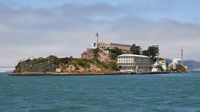In a surprising move, President Trump has ordered the reopening of Alcatraz, the notorious maximum-security prison that was closed in 1963. This decision, made public on May 9, 2025, marks a significant return to a facility that once housed some of the country’s most dangerous criminals, including infamous figures like Al Capone and George "Machine Gun" Kelly. Located off the coast of San Francisco, Alcatraz has long been a symbol of harsh detention conditions and strict isolation.
Trump's announcement emphasized that the reopening of Alcatraz will serve as a "symbol of Law, Order, and Justice." This statement reflects his administration's ongoing focus on crime and immigration, suggesting that the prison will be used to detain what he describes as "the most ruthless criminals in the country." He stated, "When we were a more serious Nation, we didn’t hesitate to lock up the most dangerous criminals and keep them away from anyone they could harm. That’s how it should be."
However, the implications of this decision extend beyond merely reviving a historical prison. Critics have raised concerns that Alcatraz could become a detention center for undocumented migrants, a move that aligns with Trump's tough stance on immigration. The president has made it clear that he intends to take action against individuals he labels as illegal immigrants, stating that the reopening of Alcatraz is a warning about what he perceives as the threat posed by illegal migration.
Trump's rhetoric suggests that only the most violent offenders will be transferred to the island, but many fear that this could lead to a broader application of detention policies that target undocumented individuals. The president's description of future inmates as “the most ruthless criminals” raises questions about who will truly end up on Alcatraz. Some groups have expressed concern that this facility could devolve into what they describe as a "concentration camp" for migrants.
Historically, Alcatraz was designed to isolate and reform the most dangerous criminals. It operated from the 1930s until 1963, when it was closed primarily due to the high costs associated with maintaining a prison on an island. The facility was known for its strict schedules and minimal contact with the outside world, which made escape nearly impossible. During its operational years, it held notorious criminals, including Alvin "Creepy" Karpis, who was considered public enemy number one at the time.
The reopening of Alcatraz has sparked a mix of reactions, from support among Trump's base to significant apprehension among civil rights advocates. Many have pointed out that the percentage of undocumented migrants in the U.S. population is relatively small, raising questions about the justification for such a drastic measure. According to data from ICE and the FBI, undocumented immigrants make up only 0.20% of the total U.S. population, while citizen residents account for 2.28%.
In a related commentary, writer Jeffrey St. Clair reflected on the history of Alcatraz and its significance, recalling his own visit to the island with former Weather Underground fugitives Bernardine Dohrn and Bill Ayers. St. Clair noted, "Not long ago, it seemed possible that Trump might be a felon in prison and at the same time the legally elected president of the US." This statement underscores the complex relationship between Trump and the justice system, as he has faced numerous legal challenges throughout his presidency.
St. Clair also mentioned the historical occupation of Alcatraz by Native Americans from 1969 to 1971, a significant event that highlighted issues of indigenous rights and sovereignty. The occupation lasted for 19 months and drew national attention to the plight of Native American communities. This historical context adds another layer to the discussion surrounding the prison's reopening, as it raises questions about who gets to define justice and who is deemed a criminal.
As Alcatraz prepares to reopen, the implications of this decision are far-reaching. The prison's legacy as a place of isolation and punishment is well-established, but its future role under Trump's administration remains uncertain. Will it truly serve as a facility for the most dangerous criminals, or will it become a tool for furthering a controversial immigration agenda?
In addition to the potential for political ramifications, the reopening of Alcatraz also raises ethical questions about the treatment of inmates. Critics argue that the harsh conditions historically associated with the prison could return, leading to a system that prioritizes punishment over rehabilitation. The broader implications for the U.S. criminal justice system cannot be overlooked, as this decision could signal a shift towards more punitive measures against those deemed undesirable.
As the nation watches closely, the reopening of Alcatraz stands as a stark reminder of America's complicated history with crime and punishment. The facility's future will likely be a contentious topic, reflecting the ongoing debates over immigration, criminal justice reform, and the very nature of justice itself. With Trump at the helm, the reopening of Alcatraz is not just a historical revival; it is a political statement that could shape the landscape of American law enforcement for years to come.






